Apple iPad mini with Retina Display: Reviewed
by Anand Lal Shimpi on November 16, 2013 8:00 AM EST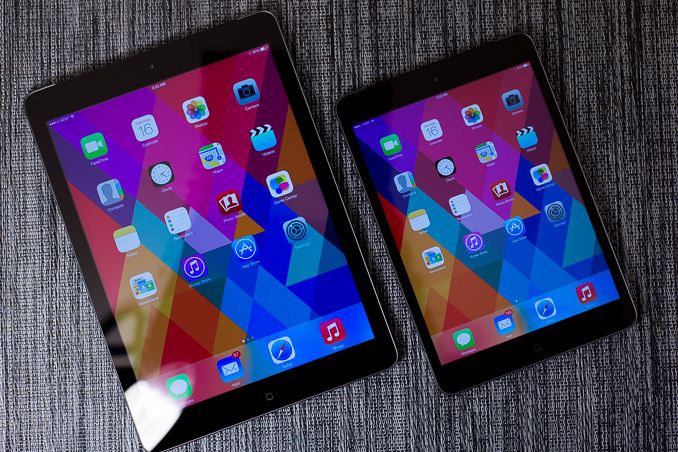
I suppose there’s only one way to start this review, and that’s by looking back at last year’s iPad mini review. In that review I had a section dedicated to the possibility of an iPad mini with Retina Display. The low resolution display and slow SoC were my only two real complaints about the first iPad mini. I listed a bunch of options that Apple had for the mini going forward:
“Apple has preferred outright quadrupling of pixel count (2x in each dimension) to create a Retina Display. With the mini's display using a 1024 x 768 resolution, this option would give it a 7.85-inch 2048 x 1536 panel. That would be the same resolution as the iPad 3/4, but in a much smaller display giving it a pixel density of 326 PPI (vs ~263 for the iPad 3/4). Apple could do this, but it would then need to make all of the same changes it made in going to the iPad with Retina Display, primarily the introduction of a larger battery and much larger SoC. The bigger battery is needed to drive the more powerful backlight, and the X-series of SoCs is needed to actually render the UI and games at such a high resolution. Both of these things would increase the size and cost of the mini, which would make it distinctly un-mini.”
What I wrote last year was more or less what Apple decided to do this year, had I stopped there I wouldn’t have ended up with egg on my face. Naturally I didn’t. At the end of that page I concluded the following:
“None of these options is particularly enticing for Apple, especially given the low (for Apple), starting price for the iPad mini. If you're expecting next year's mini to have a Retina Display, I wouldn't hold your breath.”
And this is why I don’t like making predictions.
I hadn’t expected display power to go down as much as it did. I didn’t think battery density would improve as much as it did. And I definitely didn’t think Apple would integrate a large 4MB cache on its SoCs, thereby reducing the need for a super wide memory interface. The combination of those three things made giving the iPad mini a Retina Display possible, and that’s exactly what Apple did this year.
It’s called the iPad mini with Retina Display, and unlike the iPad Air, it looks a lot like its predecessor. You’d be hard pressed to notice the 4.1% increase in thickness (+0.3mm) or the 7.5% increase in weight (+23g). Even if you did, what those slight gains net you is more than worth the effort.

From top to bottom: iPad mini, iPad mini with Retina Display, iPad Air
The Retina mini now features a 44% larger battery (23.8Wh). That’s nearly the same battery capacity as the original iPad (25Wh), but in a chassis with only 1/3 of the volume. This is also the highest capacity battery we’ve ever seen in a tablet of this size. The negligible impact on weight and thickness is pretty impressive.
The battery enables the two killer features of the new mini: mainly Apple’s A7 SoC and of course, the 7.85-inch 2048 x 1536 Retina Display. Effectively addressing my chief issues with the original iPad mini, the new mini is substantially faster and comes with a significantly better display. Keep in mind the original mini debuted with an n-1 SoC (Apple’s A5 the year the A6 came out), which makes the move to the A7 this year even more substantial of an upgrade. While casual users would be hard pressed to tell the difference between an A6 and an A7, anyone who actively used last year's iPad mini will appreciate just how much quicker the new one is (particularly if you’ve upgraded to iOS 7). It’s awesome silicon enabling a much better experience.
The display itself needs no real explanation. The first generation iPad mini featured a 1024 x 768 display, which was passable but not ideal. I had no problems recommending that mini given how good the rest of the experience was, but it’s clear that it could’ve been better. Moving to a 2048 x 1536 panel not only gives the mini the right to use the term Retina Display, but the title of highest density display in Apple’s lineup as well.
The rest of the chassis looks otherwise identical to the original mini. Apple likes to keep its mobile designs around for at least two generations, and the mini is no exception. By no means is this a complaint however. I'm just as enamored with the high quality mini chassis as I was last year. I think Apple nailed the size of the smaller iPad the first time around; 7.85-inches isn't too narrow nor is it too wide.
The face of the tablet is marked by an asymmetric bezel, identical to the iPad Air. The sides are narrow, while the top/bottom are thicker in order to accommodate the physical home button and FaceTime HD camera. Just like before, Apple does a little bit of extra work in rejecting thumbs placed on either edge of the mini to make up for the lack of side bezel to hold.
The back is a solid piece of aluminum, available in either a light silver or space (dark) grey finish. Just like with the iPhone, the silver model gets a white treatment on the front with a lighter chamfer while space grey comes with a black trim and gunmetal chamfered edge. Models with a cellular modem feature a plastic RF window along the top edge of the tablet just like the bigger iPad.
Along the edges you’ll find power/lock up top, volume up/down and a rotation lock/mute toggle on the right side. If you have a cellular model you’ll also find a nano SIM tray along the right side of the mini.
The bottom edge is home to Apple’s Lightning connector, flanked on either side by speakers. The mini sounds pretty good although you do get better low frequency reproduction out of the larger iPad Air.
The iPad mini with Retina Display features the same 5MP iSight (rear facing) and 1.2MP FaceTime HD (front facing) cameras as the iPad Air. Complementing both is a dual-mic setup for background noise removal, once again identical to the iPad Air.
The mini is available in the exact same configurations as the iPad Air. It starts at $399 with 16GB of storage, and is available in 32/64/128GB options (+$100 for each increase in storage level). Cellular connectivity is also an option, once again at a $130 adder. Just like the iPad Air, the mini with Retina Display is only available in a single LTE SKU with support for 14 different bands and ships unlocked.
| iPad Specification Comparison | ||||||||
| Apple iPad Air | Apple iPad 2 | Apple iPad mini (Retina) | Apple iPad mini | |||||
| Dimensions | 240 x 170 x 7.5 mm | 241.2 x 185.7 x 8.8mm | 200 x 134.7 x 7.5mm | 200 x 134.7 x 7.2mm | ||||
| Display | 9.7-inch 2048 x 1536 IPS | 9.7-inch 1024 x 768 IPS | 7.9-inch 2048 x 1536 IPS | 7.9-inch 1024 x 768 IPS | ||||
| Weight | 469g (WiFi) | 601g (WiFi) | 331g (WiFi) | 308g (WiFi) | ||||
| Processor | Apple A7 (2 x Cyclone 1.4GHz, PowerVR G6430) | 1GHz Apple A5 (2 x Cortex A9, PowerVR SGX543MP2) |
Apple A7 (2 x Cyclone 1.3GHz, PowerVR G6430) |
1GHz Apple A5 (2 x Cortex A9, PowerVR SGX543MP2) | ||||
| Connectivity | WiFi , Optional 4G LTE | WiFi | WiFi , Optional 4G LTE | WiFi , Optional 4G LTE | ||||
| Memory | 1GB | 512MB | 1GB | 512MB | ||||
| Storage | 16GB—128GB | 16GB | 16GB—128GB | 16GB—64GB | ||||
| Battery | 32.4Wh | 25Wh | 23.8Wh | 16.5Wh | ||||
| Starting Price | $499 | $399 | $399 | $299 | ||||
The old mini still sticks around at $299, although like the iPad 2 that’s still on sale you’d be hard pressed to hear me recommend it. Perhaps if you really don’t mind the lower resolution display, far slower SoC and want to save a little money without abandoning iOS. For most folks the iPad mini with Retina Display is where it’s at. If you’re a heavy tablet user, the experience is really night and day. While the iPad Air’s form factor is what defined its experiential improvement, the iPad mini with Retina Display relies on the display and silicon to do the same.
Weight and Usability
So much of the experience of using a tablet is tied to the weight and distribution of said weight. The iPad Air is proof of just how true that is. Whereas the iPad Air straddled the line between comfortable one and two handed usage, the mini finds itself squarely in one handed territory. Picking up the mini after using the Air for a couple of weeks feels like I’m barely holding anything. The mini is by far the more comfortable of the two tablets to hold while lying down. Sitting upright I’m not sold on the weight loss being a huge benefit compared to the mini, but if I’m relaxing the mini is just so much nicer to hold.
| iPad Dimensions/Weight Comparison | ||||||||
| iPad | iPad 2 | iPad 3/4 | iPad Air | iPad mini (Retina) | iPad mini | |||
| Height | 243 mm | 241 mm | 241 mm | 240 mm | 200 mm | 200 mm | ||
| Width | 190 mm | 186 mm | 186 mm | 170 mm | 134.7 mm | 134.7 mm | ||
| Thickness | 13.4 mm | 8.8 mm | 9.4 mm | 7.5 mm | 7.5 mm | 7.2 mm | ||
| Weight | 680 g | 601 g | 650 g | 469 g | 331 g | 308 g | ||
The chassis is narrow enough where I can just barely get one hand around the entire thing and use it like a giant smartphone. If I hold the mini in both hands like a smartphone I can actually type away super quickly using my thumbs. The latter is a use case I found myself in pretty frequently as the mini is small enough that I’d be willing to carry it with me everywhere, particularly when in a case. While the iPad Air is too big to hold in portrait mode and comfortably type on with my thumbs, the mini is too small to hold in landscape mode and use like a regular keyboard. For typing out long emails like I would on a notebook, the iPad Air is the better option assuming I can get to a desk or can sit down. If I can’t have either of those things, the iPad mini is a better companion.
Apple sent an LTE model, which basically duplicated most of the functionality of my smartphone. With the LTE mini my smartphone stayed in my pocket more, although there are tons of combinations of small/large phone/tablet that you can enumerate for optimum computing these days. In many ways it’s like the discussion between small notebook + desktop vs. large notebook + docking station.
The mini’s smaller display does make reading some content a little more difficult compared to the big iPad. Reading, particularly given the new Retina Display, is pretty good on the mini. Small text is always easier to read when it’s on a larger display, but if you’re looking at content that’s properly formatted for a tablet you’ll be in good shape on the mini. I was asked to look into the comic reading experience on the mini and also came away pretty pleased. Text bubbles were definitely not as easy to read as on the iPad Air, but overall the experience was still good in most of what I read. Ultimately you don’t sacrifice a ton of functionality if you choose the mini instead of the Air. What you do lose, you definitely make up in portability. It’s really a question of where you’re going to use the tablet that’ll determine which one to go with.
Cases
Like the iPad Air, the iPad mini is light enough that using any sort of case adds a good amount of weight to the device (percentage wise). I found myself taking the mini out of its case to use, and just keeping it protected when on the go.
Since the mini hasn’t really changed in form factor, the two first-party cases are pretty similar to what we got last year (the covers work with both mini generations). Like its bigger brother, the mini is offered with an optional Smart Cover ($39) or Smart Case ($69) depending on how much protection you want.
Apple sampled me a black Smart Cover and a Product Red Smart Case for the iPad mini. I thought both looked great on the space grey mini. It’s worth pointing out that the red Smart Case is a less saturated color than the red Smart Cover I evaluated with the iPad Air.
The Smart Cover attaches to the left side of the mini with a magnetic hinge. If you’ve lined up the magnets properly, the attractive force is strong enough to support the weight of the mini if you pick it up by the cover (though I wouldn’t recommend doing so). Magnets in the edge of the cover furthest from the hinge signal sleep/wake on the tablet itself.
The Smart Case has the same sleep/wake functionality, but instead of attaching to the mini with magnets the tablet sits inside the case for protection on both sides of the tablet. The Smart Case is what I prefer to travel with, though it is far more difficult to get in/out of and obviously adds the most weight to the device.
Both covers feature the same three fold design and can double as a stand for the tablet. Since the previous mini used the same type of cover, the angle of the stand doesn’t change like it did with the Air.
The inside surface of each cover is lined in microfiber, while the outside is made of either soft-touch polyurethane (Smart Cover) or leather (Smart Case). Both do a good job of protecting the mini and neither showed excessive wear during my review period. I still have the 1st generation mini’s Smart Cover and that one appears to have held up well over the past year.


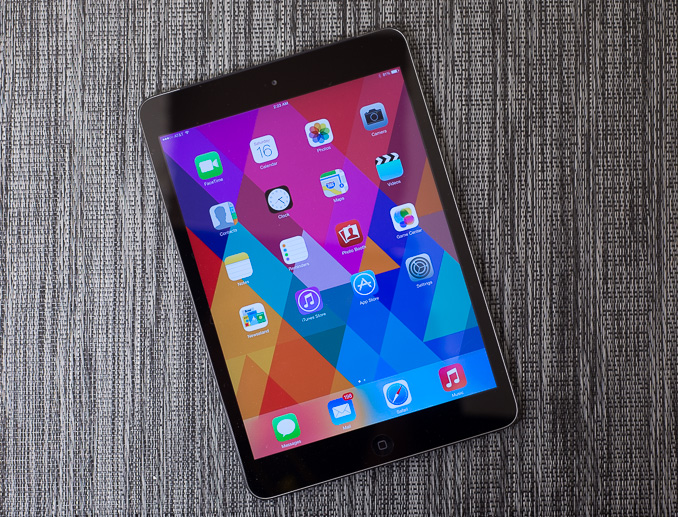
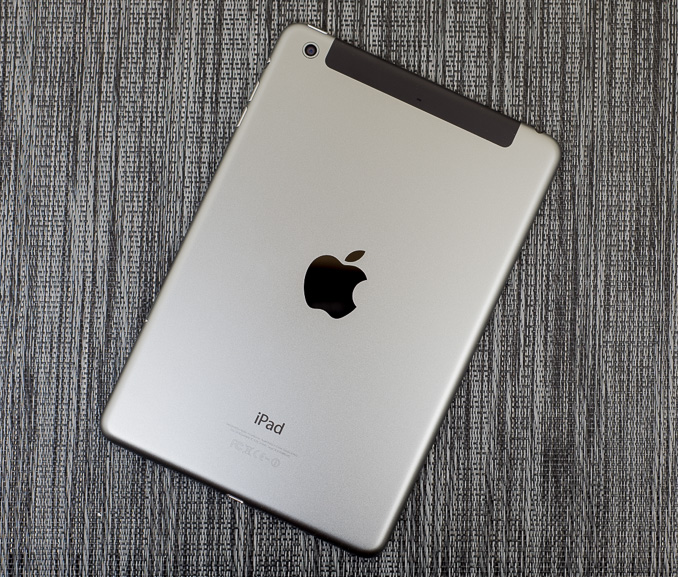
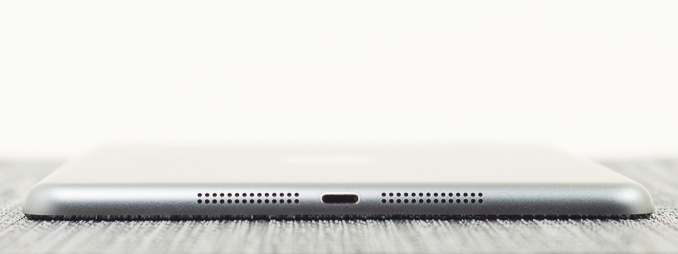






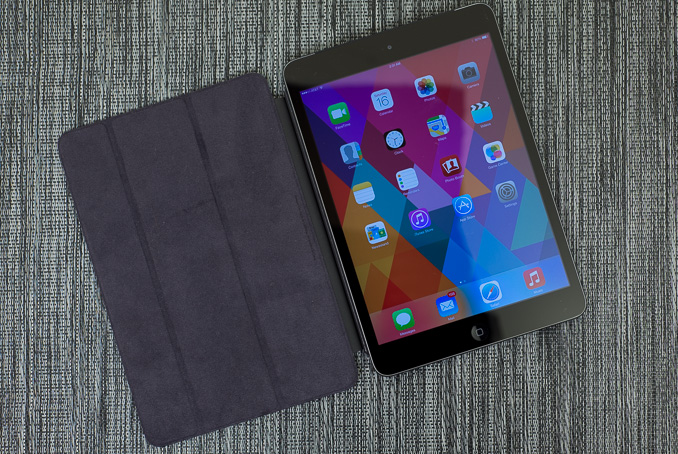
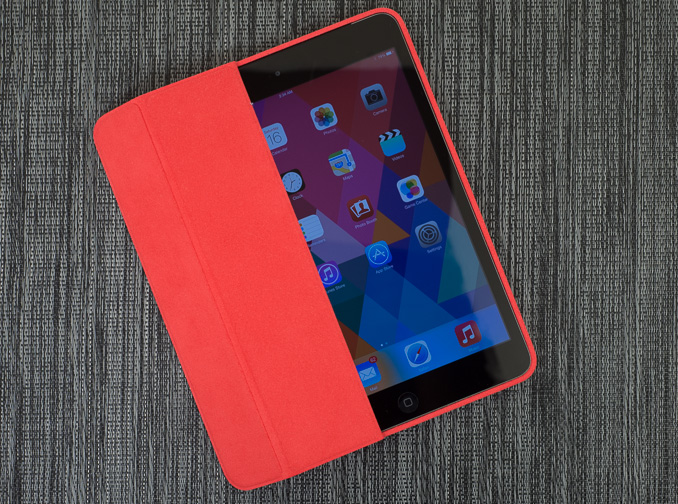









345 Comments
View All Comments
ELPCU - Tuesday, November 19, 2013 - link
Do research before talking about my knowledge or grammar.I am sorry about not born in US, so I have some grammer issue, but that does not make ur argument right.
I will tell you some of real number.
Source is IHS isuppli.
http://www.isuppli.com/Teardowns/Pages/Top-Stories...
They have done a clear analysis.
If you want to argue this number is wrong, you should bring some kind of real number with decent source.
Bill of material + manufacturing price of iphone 5s is 199bucks, while galaxy s4 BOM + manufacturing cost 237bucks. And I just check price of S4, which is 99 bucks with 2 year contract.
Oh, I have not mentioned that S4 has SD card slot, so you do not have to worry about paying 100~200 bucks for extra storage.
I know there are more expensive phones, mostly phablet. and I am sorry I do not have data for those expensive one, but their overall components cost & manufacturing cost generally more expensive than that of iphone, and those price usually go down eventually before new one release, while iphone price stays same until new iphone is released.
When I buy it, my HTC One price was 199 with contract, and now, it cost 99. Oh, by the way, HTC One does not have SD card slot, but it does not have 16GB model, but 32GB or higher. Do you want to compare it with iphone 32GB?
New HTC One Max-phablet-now costs 149. Any more question?
akdj - Thursday, December 19, 2013 - link
Your (their) numbers are wrong. Apple isn't disclosing the pricing in the aluminum process, anodizing, chip construction NOR are they 'selling' them in bulk to you and I. I own a Galaxy Note3 and a 5s. There's no way in HELL the BOM of the S4 is higher than the 5s. Or the 5c for that matter. Doesn't take a genius to see Samsung's build quality isn't top tier. Displays are killer. Nice SoC. But the plastic's gotta go! And those numbers are assuming a LOT, considering an A7SoC isn't available. Nor is the calibrated screen, casing, proprietary schematics, etc. not sure what your point is herefarhadd - Monday, November 25, 2013 - link
I'm sure if LG, HTC, Samsung, etc could sell their products with the same margins they would. Apple has a monopoly on the iOS market, and thus can charge whatever they like and people have to pay it if they want the product. If Samsung wants to introduce a revolutionary proprietary mobile OS and charge through the nose for that product, they may certainly do so. As it is they have competition to worry about.ELPCU - Thursday, November 28, 2013 - link
You are right. Most companies want to perform monopoly if they could(for example, if it is legal).But this does not mean doing monopoly is a good thing.
Apple is not performing monopoly throughout whole smartphone market, so Yes, they are doing nothing illegal, but they are doing something ridiculus. At least I can say it is a bad thing. Criticizing those ridiculus price policy is a totally fair thing to do.
Especially, considering all freaking apple product reviews became deceptive, pointing out the fact that Apple's pricing policy is ridiculus is fair. Why? because all reviews talk about price/performance with lowest storage iPad, and very strongly recommending it.
I am tired of typing out same thing. so here is another copy paste
"16GB is just not enough for iPad user. And review talks about Price/performance considering iPad cost just 499. To me, it just sounds like iPad cost starts like 599. Not just because 16GB iPad user feels lack of storage but also because Apple is intentionally holding its storage. 16GB was first gen iPad's base storage. IT IS STILL SAME for 5th generation!!"
I will still buy ipad, and still recommend it for user who seek decent entertainment device, but I am not recommending it super-strongly, because its price is really deceptive.
By the way, It is really interesting.
My point of first comment was simple as hell.
"ws3 was FREAKING WRONG AS HELL, and Apple's pricing is ridiculus."
He said "Apple's margins are not insanely high, as proven by the fact that for most of their products, they sell everything they make. How long has the iPhone 5s been out now and most Apple stores still can't keep them in stock."
Do you agree with him? You probably don't.
and NO ONE is properly arguing my main point.
However, bunch of guys pop out, and start to misinterpret my comment.
Let me summarize them all, and do slightly different short answer again
puggsly : No, he did not mean that
My answer : WTF? go back and read his comment again
Freerange1 : U failed blah blah
My answer : meh
akdj : I AM APPLE FAN BOI!, There is nothing wrong about a company making money! and BOM is not accurate way to measure margin"
My answer : OK. dude. but whole point of my original comment was about the fact that Apple has insane margin rate, and its price is ridiculus. statement 'its price is ridiculus' is more personal opinion. I still think most people will not disagree Apple's pricing-especially storage-is just ridiculus, but since you admit you are a big apple fan. let's put this opinion on the side
Do you disagree Apple have large margin rate? Probably u can't. Aren't u? that's reason why u bring out 'nothing is wrong about making money(having large margin)', because you cannot directly say Apple does not have large margin.
Plus, Look at your expression. What "Apple DOES make money"?
Oh, how cute. Again, let's face it. right expression is "Apple make A TONS OF money". Try not to hide what you see.
darwinosx : Your numbers are wrong, and your grammer is wrong too!
My answer : Any decent source? I used decent source from Market research site.
Sorry for wrong grammer though.
farhadd(YOU) : IT IS COMPETITION! A company can charge whatever price they want you to charge!
My answer : MY MAIN POINT was 'Apple has insanely large margin rate, and its pricing is ridiculus.' At least, I had not said anything about "having large margin is wrong" or made similar statement in my original comment. AND ALSO, as I have mentioned I bought iPad 4th gen a year ago, and now I have iPad mini Retina 128GB.
As a customer, can't I say its price is ridiculus?
It seems if ur friend say "I bought this, but it was terribly expensive.", are u gonna answer "All company has right to decide price of their product. If it is terribly expensive, don't buy it and don't talk about it anymore" something like this?
Yes, I probably used too harsh expression, but this is because ws3, whom I originally disputed, said something TOTALLY WRONG. Still, I might used too damn extreme expression, but I do not think I said something wrong. Do you think ws3 is right?
Although I have picked up, and answered every single bit of those comments. None of you guy is properly(I mean with decent evidence) disputing my MAIN point.
I am stoping HERE, because I feel none of you guy can disagree my main argument reasonably.
I apologize for my harsh expression, but I feel you guys are enthusiastically excusing Apple rather than having disputing, which make me to use even more damn BS expression.
ekotan - Tuesday, December 17, 2013 - link
I understand your point, but I don't see why it matters. Tablets are luxury products, not necessities; and all luxury products, by definition, command high margin.Yes, the margins are high. So what? People don't make purchasing decisions based on the manufacturers' margins, they make purchasing decisions based on the price of the product and its (perceived) value & benefits.
akdj - Wednesday, December 18, 2013 - link
Interesting comment considering ALL flagship phones are charging $100 for each storage increase. As well, their non subsidized price being essentially equal! HTC One, S4, Note 3, G2---all $650-$700 phones, identical to the iPhone. WTF are you throwing a tizzy about? Smart businesses make money. Smarter businesses make more money with better products. Pretty simple, actually common senseguardian1935 - Tuesday, March 11, 2014 - link
Your ridiculous spelling of ridiculous is ridiculous, sir.ELPCU - Monday, November 18, 2013 - link
Winkgood // For iPad mini, I think it is sort of excusable.Yes, I sort of understand your argument as well.
Apple generally keep price same. But note original ipad mini cost was pretty low. Not just in terms of absolute price, but also in terms of margin, its cost is not that high. 1st gen iPad mini has lowest margin rate among iOS device, which is still decent amount of margin.
But making it as Retina cost a lot, as Mahadragon mentioned.
Also, comparing increasing resolution of phone and iPad mini is not same. iPad mini has significantly large display with more pixels, which means diplay cost is much bigger matter for iPad mini, and battery size is bigger issue as well.
Yes, iPad has not increased its price when it move into Retina display, but they sacrificed significant amount of margin per unit for that one. And iPad mini does not have that 'extra margin'.
I cannot say too much about margin rate of iPad mini Retina since I do not have accurate number, but during iPad 3rd gen has about 40 bucks higher bill of material. compared to BOM of iPad 2 just after iPad 2 release. It refers Apple had to spent 40 bucks more for each iPad, which means they gave up about 60 bucks per unit price. Considering resolution of iPad mini and iPad are same, despite of size difference, I expect similar or slightly lower BOM increase.
If Apple do not increase price to negate those manufacturing price, iPad mini 16gb wifi will go in about 'zero margin' area.
Apple can still makes some money with their storage pricing(yeah, 100bucks per every bit of storage!! that's what I call rip-off! ), accessory, and App selling, but I do not think Apple is a company who want to sell zero margin tablet, and I do not think it is wise in terms of company strategy, considering current apple's position--strongest company in tablet market.
puggsly - Monday, November 18, 2013 - link
I was wondering how Apple would both increase resolution and bump the CPU to the A7 and was surprised at the solution of upping the price. Not that it wasn't a good compromise but I'm afraid that Tim Cook is paying too close of attention to margin and missing the revenue boat. If people remember how shocked the tech community was that the first iPad hit a $499 price point at 16GB of storage, you know that Apple was charging a premium price for a premium product but that it was seen as a good value. Now here we are almost 4 years later and the entry level iPad and iPad Mini are 16GB!!! 4 years ago 16GB went further than it does today and Apple NEEDS to shift the entry level on it's products to continue to push the idea of Premium value.For many users 16GB will not be the premium user experience Steve Jobs demanded and Cook needs to balance that with margins. It will piss off some consumers but this can't wait till the next annual refresh. So maybe Cook does a Feb/Mar spec bump on the line to double the Storage and keep the price.
Also, the cost of the cellular options needs to shift down to $70-$99 because the high end purchasers are going to balk as the price point climbs....I know I am. $629 for the 32GB mini with cellular is a tough choice. But at $499 I might end up with two this christmas.
darwinosx - Tuesday, November 19, 2013 - link
Iv'e bought four Nexus 7s as gifts but prefer the Mini for myself. 35% more screen space is a big deal and the apps are better with more selection. It's also quite a bit faster than the Nexus 7 which is very apparent if you have used both. The Nexus 7 is sold at cost so it's an amazing value but it also feels cheap compared to a Mini.